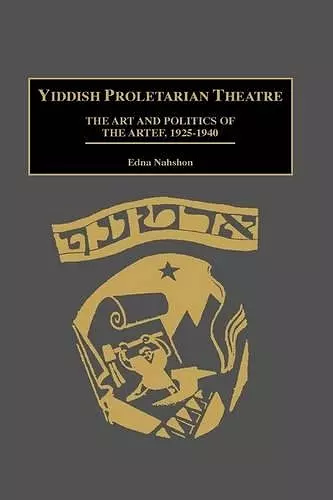Yiddish Proletarian Theatre
The Art and Politics of the Artef, 1925-1940
Format:Hardback
Publisher:Bloomsbury Publishing PLC
Published:27th Aug '98
Currently unavailable, and unfortunately no date known when it will be back

Examines a major Yiddish art theatre that was also one of the most important companies of the American theatre of social consciousness.
The Artef (1925-1940) began as a radical Yiddish workers' theatre and developed into a major American Yiddish theatre company. This is a major work in Jewish Theatre Studies that will be of great use to scholars and other researchers involved with Jewish and Performance Theatre Studies as well as the history of the American Left.
The Artef (1925-1940) began as a radical Yiddish workers' theatre and developed into a major American Yiddish theatre company. It was among the acknowledged pillars of the Theatre of Social Consciousness, a movement that redefined the course for the American stage during the half century that followed. In the 1920s and 1930s, New York was widely recognized as the world capital of the Yiddish theatre. The Artef was a principal theatrical institution during this so-called Golden Era. Established in 1925 as a proletarian theatrical organization affiliated with the Jewish section of the American communist movement, the Artef was hailed by Brooks Atkinson as one of the artistic ornaments in town. In 1934 the Artef moved to Broadway, where it continued to perform until its demise in 1940. This work examines the history of Artef and analyzes the artistic, ideological, and organizational aspects of its work. The company's major productions are discussed, with a focus on the central issues raised by script, direction, and acting. The book attempts to demonstrate that radical politics often shaped and determined the evolution of the theatre, and that its artistic and organizational life must be seen within the context of the political and cultural movement of which it was a part. The work is divided into three major segments: Chapters I-IV discuss the ideological, social, and cultural forces that gave rise to the Artef, the crystallization of the organization, and the work of its acting studio, which in 1928 became the acting collective of the Artef; Chapters V-VIII cover the period of 1929-1934, the formative years of the Artef and their correspondence to communist Third Period doctrine; Chapters IX-XIII are devoted to the theatre's successful Broadway period, which paralleled the Communist Party's liberal Popular Front era. The last chapter discusses the efforts to revive the Artef, and its inevitable demise following the 1939 German-Russian Nonaggression Pact. This is a major work in Jewish Theatre Studies that will be of great use to scholars and other researchers involved with Jewish and Performance Theatre Studies as well as the history of the American LISBN: 9780313290633
Dimensions: unknown
Weight: 652g
288 pages